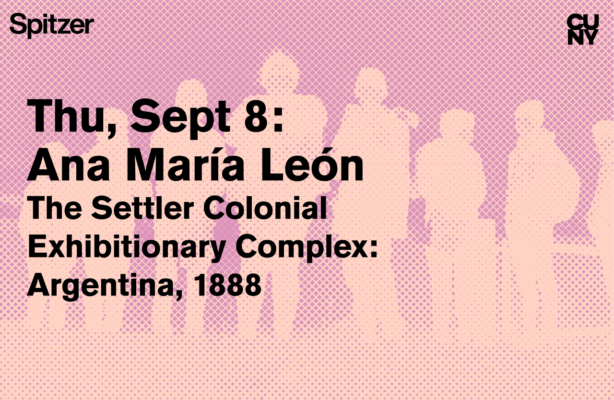News
Ana María León Lecture Recording
This lecture was held in-person on 9/8/22 and was part of the Fall 2022 Sciame Lecture Series, titled “Border Crossings: Architecture and Migration in the Americas.”
Ana María León‘s work traces how spatial practices and transnational networks of power and resistance shape the modernity and coloniality of the Americas. Her research and teaching foregrounds the agency of populations under struggle and the multiple forms of bias embedded in the built environment and its histories. León is author of Modernity for the Masses: Antonio Bonet’s Dreams for Buenos Aires (University of Texas Press, 2021) and A Ruin in Reverse / Bones of the Nation (ARQ, 2021) and teaches at the Harvard GSD, where she is associate professor.
“The Settler Colonial Exhibitionary Complex: Argentina, 1888”: Thinking about the project of an Indigenous modernity, Aymara Bolivian scholar Silvia Rivera Cusicanqui has described how this project emerges from a non-linear understanding of history, in which the past-future is contained in the present. In this talk, León reflects on the historiographic possibilities of this approach through her research on the Museum of La Plata. This building can be understood as an apparatus that allows us to trace different networks of exchange operating at vast distances in time and place: from the British Empire to the Argentinian pampas, from Pleistocene bones to the nineteenth-century wars against the peoples of the Americas — and finally, from an imaginary remote past to a settler colonial present. Standing at the crux of these networks, the museum was instrumental in dissociating Indigenous populations from their contemporary context and presenting them instead as subjects belonging to a distant past. In doing so, the institution was and remains complicit with processes of genocide and empire expansion, linking these networks of resource extraction and industrialization to the decimation of one of the oldest populations of the American continent.
Dean Marta Gutman and Visiting Scholar William Brinkman-Clark will introduce the speaker.
Suggested Reading: Bones of the Nation
“Border Crossings: Architecture and Migration” in the Americas presents meditations on the topic of migration from nontraditional, creative, and interdisciplinary perspectives. The distinguished speakers — architects, landscape architects, architecture historians, social historians, a philosopher, an anthropologist, and an attorney — question conventions, especially the conceptualization of migration as linear. They frame migration as a multivalent process, considering the lived realities and material conditions of migration, historically and in the present. Migration in the Americas is more than just the movement and resettlement of bodies, numbers that cross lines and appear/disappear in different places. Migration is not merely (dis)placement, it is also a metamorphosis. Migrants are human beings who are transformed to the core by their movement, and they transform not only their places of departure and arrival, but the entire space that is filled with their journeys.
This lecture series is made possible by the Spitzer Architecture Fund and the generous support of Frank Sciame ’74, CEO of Sciame Construction.


